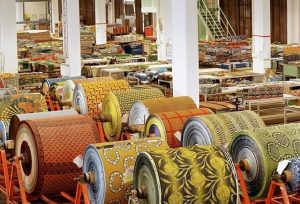Onome Amuge
Africa’s cotton, textile, and apparel (CTA) sector, despite its potential, remains largely underdeveloped, hindered by a reliance on raw material exports and an influx of foreign finished goods. This was the assessment delivered by experts in the industry during a recent webinar titled “AFRICA’S COTTON, TEXTILE AND APPAREL INDUSTRY: MARKET STRATEGIES UNDER AfCFTA”, hosted by the International Trade and Research Centre (ITRC)
Emeka Nkwoala, deputy general secretary of the National Union of Textile, Garment and Tailoring Workers of Nigeria (NUTGTWN), in his presentation, emphasised the urgent need for value addition and strategic leveraging of the African Continental Free Trade Area (AfCFTA).
Nkwoala noted that with 37 African nations producing cotton, the continent accounts for 5-7 per cent of global cotton production, with West Africa contributing 60 per cent of that share. However, Nkwoala observed, “Most of the cotton is being exported in a raw form, but we need to add value to it.” This practice, he lamented, deprives African economies of crucial job creation, industrialisation, and export growth opportunities.
According to the NUTGTWN DG, the CTA sector holds immense promise for Africa’s industrialisation and job creation due to its diverse skill requirements, accommodating highly skilled, semi-skilled, and low-skilled labour. Despite this, Nkwoala pointed out numerous impediments to its growth, including a severe lack of investment in processing and affordability, inadequate regulatory oversight, over-reliance on imported inputs, limited infrastructure, high energy costs, outdated machinery, and restricted access to finance.
A particularly damaging challenge, Nkwoala stressed, is rampant smuggling and competition from cheap imports, especially second-hand clothing. “Africa is said to be the largest importer of second-hand clothing products globally, absorbing 30% of the total sold worldwide,” he noted, linking this phenomenon to the de-industrialisation of local industries and negative socio-economic impacts. “We cannot be the most fashionable people in the world, and then we resort to bringing in secondhand and clothing into our continent. It has a negative effect,” he noted.
Nkwoala emphasised that the African Continental Free Trade Area (AfCFTA), a landmark agreement encompassing 54 African Union members and a market of over 1.4 billion people, offers a very huge market and a critical opportunity to transform the CTA sector. He acknowledged that prioritising cotton regional value chains, the AfCFTA aims to boost intra-African trade, industrialization, and economic integration. However, realising its full potential demands a comprehensive strategy, including robust safeguards against unfair trading practices.
Nkwoala underscored the imperative for African nations to cease exporting raw cotton and instead focus on producing finished goods. This shift, he argued, is vital to address the current trade imbalance, where Africa imports goods worth $23.1 billion annually while exporting only $15.5 billion.
Dwelling on rebuilding the CTA sector, Nkwoala highlighted recommendations including; Developing supportive policies, addressing structural constraints like unreliable and expensive power, enhancing customs management to combat illicit trade, and creating an African quality and standard system that emphasises environmental sustainability.
Notably, Nkwoala called for a strong commitment to promote patronage of made-in-Africa textile. “We must wear what we produce and produce what we wear,” he stated , while urging government leaders, military, paramilitary, and public schools to prioritise locally manufactured goods to stimulate domestic production.
Nkwoala further stressed that the AfCFTA is not merely about trade but about trade for development, trade for industrialization, and trade for job creation and retention. Achieving this, he reiterated, hinges on collective action, policy alignment across African countries, and bridging the persistent gap between policy formulation and implementation.
Abel Mwenda Kamau, a trade and policy specialist also shared a similar sentiment at the webinar, where he noted that Africa’s vast potential in the textile and apparel sector is ripe for exploitation, but requires a strategic approach that moves beyond broad generalisations to address the distinct needs of each segment of the value chain.
Kamau highlighted Africa’s rich endowment of natural fibres, including cotton, sisal, and wool, contrasting this with a lagging development in synthetics like polyester and nylon, largely due to underdeveloped petrochemical industries. He emphasised the lengthy and complex nature of the textile value chain, from fiber production and spinning to fabric manufacturing, finishing, and garment creation. A major challenge, he noted, is the tendency to grab all the challenges and all initiatives towards growing it into one basket.
Kamau advocated for a disaggregated approach, treating each stage of the value chain as a distinct economic sector requiring tailored policy interventions. “It’s one long value chain whose policy interventions, whose approaches need to be customized to fit the uniqueness of each of the segments,” he stated, suggesting that it should be viewed as five distinct value chains within one bigger sector.
While cotton has historically been dominant, Kamau pointed out a growing trend towards synthetics, which are increasingly offering similar operational and functional parameters to natural fibers. He stressed the importance of developing Africa’s capacity in both organic natural fibers, which are gaining traction as premium products, and synthetics to meet diverse market demands.
According to the trade expert, an opportunity for African manufacturers lies in bridging the consumption gap within the continent. He observed that with an average per capita fibre consumption of 2.5 to 3 kilogrammes per year, Africa lags far behind regions like the US (40 kg), Europe (28 kg), and China (25 kg). “This is one of the single biggest opportunities that African manufacturers have,” Kamau asserted, warning that if local producers do not seize this chance, it is an opportunity that will be taken up by manufacturers outside the continent.
According to Kamau, future market drivers in Africa will continue to include price, culture, and quality, but sustainability is rapidly emerging as a crucial factor. Furthermore, he noted that there’s a growing desire among African consumers to feel good about what is produced by them, indicating a rising interest in homegrown African brands and the Africana product offering.
To capitalise on these trends and leverage the AfCFTA, Kamau outlined key market strategies. These include embracing mass market customisation over mass manufacturing to cater to the diverse tastes across 55 African countries, appropriate pricing for varied market segments, robust brand development, and aggressive retail market development. He also underscored the importance of quality, urging manufacturers to develop products that are specifically made with the size of the African at mind.
Kamau envisions an African textile industry that not only serves its growing domestic market but also positions itself as a global manufacturing hub. “As Africa develops its sector, we are not just developing it for Africans, but also for the world at large,” he stated.
Also speaking at the high-impact webinar, Muktar Dodo, the Representative in Africa at the Global Organic Textile Standard (GOTS) , outlined a strategic vision for the sector, emphasising a shift towards organic cotton production and global certification to regain market share.
Dodo noted that historically, Nigeria’s textile sector flourished by serving a strong domestic market, producing everything from wax prints to military uniforms. However, the 1990s marked a decline, largely attributed to the importation of products from competitive markets and the consequences of trade liberalization following Nigeria’s entry into the World Trade Organization. He added that this influx of cheaper foreign goods severely hampered local production and competitiveness, leading to widespread factory closures and massive job losses.
“In the 1980s, the textile industry employed over 500,000 people,” he stated, highlighting the sector’s immense employment potential. “If we could have that in today’s Nigeria of 210 million, I think we would not be complaining so much about unemployment,” he added.
The path to revival, according to Dodo, lies not in replicating past strategies, but in adapting to contemporary global market demands. “We are not going to go back to the old playbook,” he asserted.
“We are going to look at what the market needs right now and take advantage of that,” he said, noting that the key to this resurgence is sustainable fashion and textiles, a growing trend driven by consumer concern for environmental and social impact.
The GOTS representative pointed to the significant opportunity presented by organic cotton production. According to him, unlike conventional farming, organic agriculture avoids harmful chemicals, benefiting farmers and preserving soil health, adding that Nigeria possesses vast arable land suitable for organic cotton, offering a competitive edge.
He described the Global Organic Textile Standard as a crucial certification, ensuring that textile products meet stringent environmental and social criteria, including fair wages, no child labour, and the absence of harmful chemicals.
“Certification is the only assurance you can give to your business partners and to the final consumer, that your product is responsible,” he emphasised.
Dodo further argued that achieving GOTS certification would open doors to lucrative premium markets worldwide, allowing Nigeria to tap into the projected $18.1 billion organic cotton market by 2025.
According to him, this strategic opportunity promises not only to revive an ailing industry but also to create over a million new jobs in rural communities, fostering a more sustainable and prosperous future for Nigeria’s textile sector.









